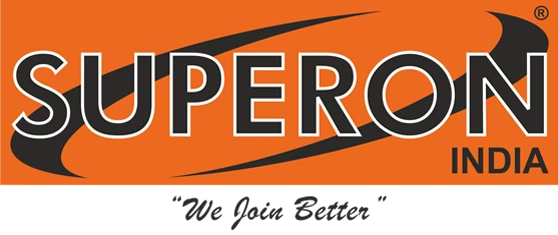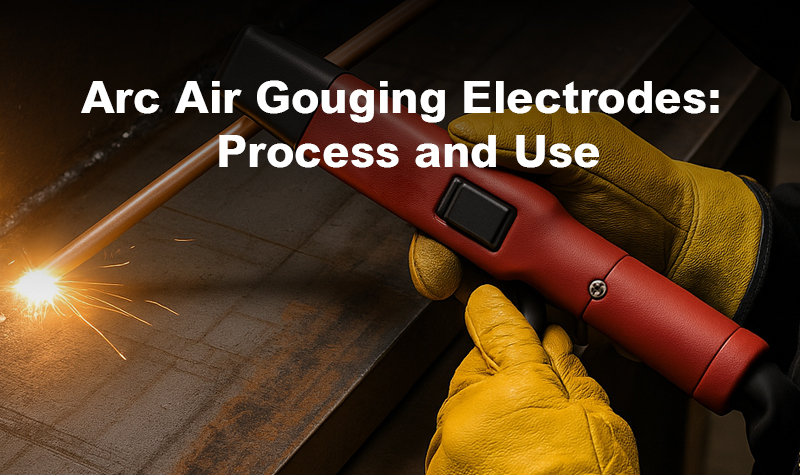Arc air gouging is a common metalworking process utilized to cut, clean, and strip material off a workpiece. The process is suitable for heavy-duty usage, and arc air gouging electrodes are a required part of the process. Knowing how the electrodes work and where to use them can make welding and fabrication processes efficient and safe. We are going to cover the fundamental principles of arc air gouging, operation, and electrodes in this blog, and some applications in industry.
What is Arc Air Gouging?
Arc air gouging or air carbon arc gouging is a process in which the arc is generated between the workpiece and electrode through the use of a carbon electrode. An extremely high temperature of the electric arc will melt the metal and compressed air will be blown over the molten metal, and it will be forced out and will create a gouged groove. This process is used most frequently in operations such as the removal of weld metal, surface cleaning, cutting heavy metal sections, and repairing faulty welds.
The process also possesses some significant benefits over other processes that are gouging or cutting in nature such as plasma cutting and oxy-fuel cutting. These are:
- High-Speed Material Removal: Compressed air assists in helping to force the molten metal at high speed to enable quick material removal.
- Deep Penetration: The arc can produce a lot of heat and, therefore, can penetrate heavy material with ease.
- Low Heat Affected Zone: Arc air gouging produces a lower affected heat zone than some processes, which makes it less likely to warp or damage the workpiece.
While arc air gouging is especially worth its weight in gold for some industrial use, the operation is highly electrode-type- and quality-dependent.
How Do Arc Air Gouging Electrodes Work?
Arc air gouging electrodes have the responsibility of creating the arc and transferring electricity to the workpiece. The electrodes are usually manufactured from a mix of carbon and copper, although other types are employed based on the particular needs of the operation.
Major Parts of Arc Air Gouging Electrodes
- Carbon: Carbon is utilized as the predominant material consumed by arc air gouging electrodes because it possesses electrical conducting properties and heat resistance generated when gouging. The presence of carbon enables the electrode to maintain an even arc and transfer the necessary heat to melt the metal to be treated.
- Copper Coating: Copper coating on most arc air gouging electrodes facilitates conductivity and resistance to wear. Copper's good thermal and electrical conductivity enables the arc to burn more smoothly and corrosion resistance causes the electrode to remain in use longer.
- Length and Diameter: The diameter and length of the electrode would change according to the thickness of be gouged material. The most utilized electrodes are 3/16 inch (4.8 mm) to 1/2 inch (12.7 mm) diameter, though greater thickness can support more substantial electrodes. Length would be a fixed measurement, i.e., 12 inches (300 mm), though longer ones are manufactured.
- Insulation: Electrodes are typically insulated at one end so that the arc is created in the intended location and is not inadvertently shorted against other welding equipment or surfaces.
How the Process Works:
The gouging process starts when the electrode is inserted into the electrode holder, which is connected to a power supply that provides DC or AC Current. The operator then completes the arc by placing the workpiece against the electrode. Upon striking the arc, the massive heat produced ignites the metal in the target location to start burning. Compressed air is also sprayed onto the molten metal at the same moment, quickly removing the melted metal and hence forming a gouge.
The electrodes should be able to sustain the arc heat as well as produce efficient material removal. The carbon electrode is constantly being vaporized throughout the process and should therefore be replaced occasionally to ensure continuity.
Types of Arc Air Gouging Electrodes
Arc air gouging electrodes are available in different grades and sizes suitable for particular purposes. The following are the most sought-after ones:
Pure Carbon Electrodes:
They are made of superior-quality carbon and are built to create the most stable arc and highest heat resistance. Carbon electrodes are also used when gouging in a general sense and are suitable for metals such as aluminium or copper.
Graphite Electrodes:
They have graphite, a carbon compound, that increases the resistance of the electrode to high temperatures and arc stability. Graphite electrodes work best when cutting thick materials like steel and cast iron.
Copper-Coated Electrodes
Copper-coated electrodes blend the excellent conductivity of copper and carbon's durability and bring them together for more aggressive gouging work. The copper coating, in addition to lengthening the life of the electrode, also aids in making the gouging process more efficient overall. Copper-coated electrodes find wide application in high-performance applications like shipbuilding, steel construction, and heavy equipment repair.
Special Alloy Electrodes:
In some situations, the companies provide electrodes manufactured from custom-made alloy material to serve specific welding or gouging jobs. These types of electrodes find application in high-performance tasks in which regular carbon or graphite electrodes may not prove effective, including the cutting of hard steels or super alloys.
Where to Use Arc Air Gouging Electrodes
Arc air gouging is a particular method in regular use for numerous industrial applications. Some of the most prevalent uses are as follows:
Weld removal
Arc air gouging is equally applied for the removal of deformed welds. When welds are cracked, porous, or have any other type of such flaws, then they would need to be ground away and resurfaced. Arc air gouging permits the removal of weld metal with ease without harming the near-base metal.
Surface preparation
In shipbuilding, pipeline construction, and repair of heavy machinery, surfaces should be cleaned prior to the execution of the welding or coating operation. Arc air gouging can be used in cleaning weld surfaces, stripping rust, scale, or other material, and preparing surfaces for the next process.
Cutting Thick Metal Sections
Arc air gouging is the most effective among all the methods utilized to cut heavy metal sections like beams, plates, or structural members. The process is fast, and material extraction is accurate, and thus it is the preferred first-choice technique in cutting heavy metal sections for fabrication plants or building sites.
Groove Cutting and Beveling
The arc air gouging operation can also be employed for grooving or beveling metal workpiece edges. This is particularly convenient in the preparation of parts to be welded or in establishing a joint geometry where a particular shape or angle is needed.
Pipe and Tank Cutting
In all places where heavy tanks or pipes must be cut, including the oil and gas industry, power plants, and chemical process plants, arc air gouging is a great and cost-effective choice. It enables employees to cut thick-walled pipes and tanks quickly, particularly in tight spaces.
Repair and Maintenance
In heavy equipment repair and maintenance, arc air gouging is employed primarily in surface preparation and stripping of worn-out or old metal for re-welding or replacement. Examples of such operations include the following: engine block crack repair, pressure vessel, and other large-sized parts.
Metal Alloy Cutting
For the use of hard alloys such as high-carbon steel or stainless steel, arc air gouging is primarily employed due to the capability of accommodating temperatures needed to hold the metals in place together. The process is also efficient at minimizing thermal distortion when dealing with high-performance alloys.
Also Read: Superon 7018 Electrodes: Your Versatile Welding Companion
Conclusion:
Arc air gouging electrodes are used in the arc air gouging process, delivering the heat and material removal necessary for most industrial applications. The right electrode is what makes the difference in the performance, economics, and quality of the gouging process. Whether you are stripping out bad welds, surface preparation, cutting thick metal plates, or repairing; an understanding of the operation of these electrodes and using the right one for your task can transform your operations.
With proper electrodes, you've got smoother work, less downtime, and more total productivity, so arc air gouging is an extremely useful tool in a very broad spectrum of industrial applications, from construction to fabrication to shipbuilding and beyond.
Also Read: Navigating Welding Electrodes: A Concise Overview

